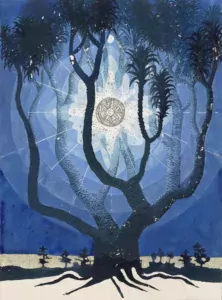This question, asked by Hamlet in Shakespeare’s play of the same name, seems to be the question men often ask when they discover their inner world of spirituality. In other words, unlike Hamlet who was considering suicide, I am using this question to broach the dilemma that many men face in opening to vulnerability and a contemplative mode of living/being. This awakening can be confusing and even frightening thus forcing an action of running from or into the Mystery. While reading the letters to the editor recently in the Spiritual Directors International magazine “Presence”, I came across a letter addressing two articles in the previous issue of the same magazine. The writer was fairly upset about the content of the two pieces which dealt with spiritual direction for women and the other with male spirituality. They felt that “God truly has nothing to do with gender . . . [it] should be a non-issue for us as well . . .” The odd over sight in this observation is that if God is our creator, then God must have had some serious interest in our being put together as we are. And that if we reflect God’s image it surely is in both the similarities and uniqueness that we exhibit as gendered beings. Thus I would like to briefly and in general, reflect on some of those things that science has discovered that does seem to display differences, not superiority, in how we approach life, including spirituality.
The womb seems like a good beginning. In Dr. Gurian’s book The Wonder of Boys, he writes, “. . . the hormone testosterone surges . . . early in the pregnancy, making the boy’s genitals drop. Then, in the middle months of the pregnancy, testosterone surges again, giving the boy a male brain.” (Gurian, 1997, 8) Dr. Marian Diamond presented a lecture in which she discussed that the fiber tracts between the two hemispheres appears to be larger in females. She notes that this symmetrical brain structure is a possible link to the primordial roles of childbearing and care and the need to go in many directions theoretically and geographically. This stands in sharp contrast to the male brain’s primordial visual focus and development as was needed in a hunter gatherer culture. (Diamond, “Male and Female Brains”, a summary, 2003, 5 of 6)
This very brief tour of our earliest developmental stage may leave you asking what has this to do with you today and with your spirituality. In the book, Deepening Psychotherapy with Men, the authors look at four problems modern males face: conflicts with dependence; general cultural emotional prohibitions; problematic structuring of male specific images of self and function, and an inclination toward doing over being. (Rabinowitz & Cochran, 2006, 17) FEEL familiar? These tie in with the male brain hard wiring and the brain’s focus on the visual spoken of above. Returning to Gurian’s book he writes about the role of testosterone in the male make up: search for instant satisfaction; moving quickly to problem solving and finding activities through which the body constructs physical tension and then releases it quickly. (Gurian, 1997, 11) This is seen in how we do physical work, do sports and approach sex – again, generally speaking. Contrast this with the four problems and one can see important connections and some ways to construct answers to these issues. Those of us who have attended the rite of passage for men, developed by Richard Rohr and associates, will well remember bumping into these four problems in some way and feeling the freeing effect of the ritual experience at some level.
The male awakening to the inner life every human being has, can happen in many ways: marriage, the birth of a child, the death of someone deeply loved or the developmental transitioning that occurs in aging. The problem that is faced in these possibilities is that without a maturing spiritual discipline, these awakenings will naturally fade as time passes. The chance for God’s challenge for our growth and transformation are sorely limited. I saw this in my own life and was saved from it on several occasions by the intervention of spiritual directors, books, other people, and in 2008, the Rites of Passage for Men mentioned above. Carol Gilligan writes in her book, In A Different Voice, that a woman’s identity is defined by relationship. (Gilligan, 1982, 160) I think at some point in the male inner journey we are invited into this female energy of relationship, which requires vulnerability. Something gentleman, we, for the most part, are often very afraid to face or admit. In John’s Gospel, we see the use of this energy in the story of the women caught in adultery. Movies like to show her thrown down, but in the scripture she is forced “to stand in front of everyone.” Jesus had begun to teach earlier in the temple precincts. After her accusers bring her to him and demand his opinion about her being stoned as the Mosaic law demanded, he silently bends over and scribbles in the dust. This is not a position of power but of silent being. He stands up to assert his male energy of confrontational authority, only when the accusers insist that he respond. He then bends back down and into silent being while scribbling in the dust. When he rises a second time, it is out of his female relational energy as he enters into a dialogue with the woman. (John 8: 1-11) This is servant, generative energy in both instances. I think this where most of us would like to grow and learn to be more open to the Mystery of self and the OTHER. This seems to be the answer to the question, “To be or not to be?”
I hope this has been helpful in exploring what our maleness may mean and what an authentic call to manhood could look like. Blessing to you all.
Mike Whitman





